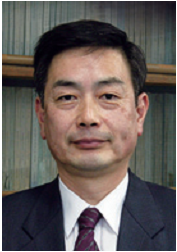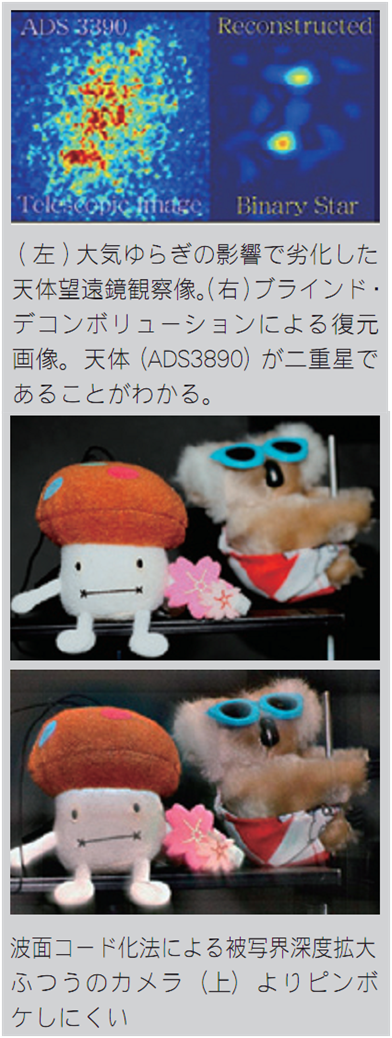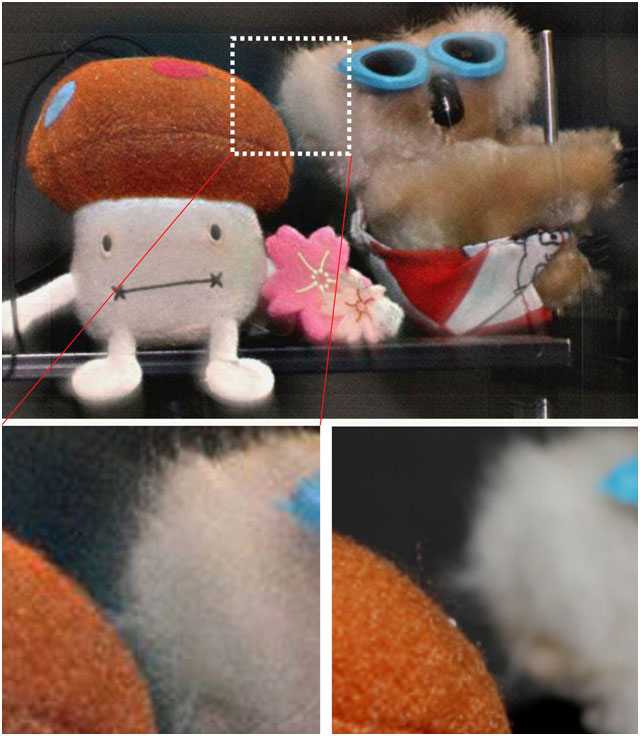
ページ読込中...

ページ読込中...

[English]
| 小松 進一 [教授] |  |
|
| homepage | https://www.opt.phys.waseda.ac.jp/ | |
| 専門分野 | 光物理工学研究 | |
| 研究テーマ・研究活動 | ||
| 1972 年 早稲田大学理工学部応用物理学科卒業 1974 年 早稲田大学院理工学研究科修士課程修了 理化学研究所研究員補 1978 年 理学博士(早稲田大学) 1980 年 早稲田大学理工学部・助教授 1985 年 早稲田大学理工学部・教授 |
||
光通信・情報機器からバイオ・宇宙にいたる先端科学技術の幅広い分野で、光は重要
な役割をはたしており、「21 世紀は光の時代」といわれています。
光は非常にすぐれた情報の担い手です。光波の振幅・位相・偏光状態などで、さまざ
まな情報を時間・空間・周波数の関数として表すことができますし、光の反射・屈折・
散乱・吸収・増幅などのいろいろな物質との相互作用を介して情報を高速・高密度に記録・再生することができるからです。また光の量子的な性質を利用すればさらにその可能性が拡がります。
本研究室では、新しいレーザー応用の開拓を中心として、光の波長より細かい微細構造の中での光のふるまいの解析から、新しい機能の光デバイスや多次元光情報処理システムの開発まで幅広く研究しています。

また、光と画像は縁が深く、光情報処理や可視化技術のほか、コンピューターによるデジタル画像処理にも取り組んでいます。
上の図には、劣化した星像だけを用いて元の天体の形を推定するブラインド・デコンボリューションの例が示されています。この図の左は望遠鏡で観測した天体写真で、大気の屈折率ゆらぎの影響を受け、すりガラスを通して眺めたように大きく像が広がっています。この天体写真のほかに手がかりがなくても、特殊なアルゴリズムを用いて画像復元を行うと、図の右のように、この天体が二重星であることがわかります。
下の図は、波面コード化法による被写界深度拡大実験の結果です。ふつうのカメラで撮影した写真(上)ではピンけしている遠方の物体が、下の図ではシャープに写っていることがわかります。
このほか、情報フォトニクス、光計測、イメージサイエンスの分野で、コンピュータを利用する像形成や可視化技術、補償光学の小型化・高機能化、光カオスによる秘匿通信、ファイバー・ブラッグ格子センサー、金属ナノ粒子鎖による光導波路などの最新の課題に、「不思議さ」に対する感覚を大切にしながら取り組んでいます。
| Shinichi Komatsu [Professor] |  |
|
| homepage | https://www.opt.phys.waseda.ac.jp/ | |
| research field | Extending Image Field Depth without Reducing Resolving Power and Light Intensity | |
| research keywords | ||
| Wave-front Coding for Extending Depth of Field Compact Adaptive Optics for Industrial Use Phase Recovery of Light Wave and Blind Deconvolution Heterodyne Laser Scanning Microscope Dynamic Phenomena of Laser Speckle |
||
| link | ||
| Research Profiles (at Faculty of Science and Engineering) | ||
Reducing the pupil size of an imaging lens is the most convenient way to extend the depth of field, but it inevitably results in the reduction of both the resolving power and the amount of light transmitted through the lens.
Wave-front coding (WFC) is well-known as an efficient technique for extending the depth of field without causing such inconveniences. The WFC technique requires a phase mask to modulate the pupil function of the lens as well as the corresponding post image processing for decoding. To achieve a further extension of the depth of field, we newly designed a freeform phase mask (FPM) instead of a conventional cubic phase mask (CPM). We optimized the shape of the FPM using the simulated annealing algorithm and confirmed that the optimized FPM provides a much larger focal tolerance and better final images than the CPM.The wave-front coding (WFC) system is a pupil-modulated optical system that presupposes the corresponding subsequent digital image processing, and has been extensively studied as one of the most effective means of extending the depth of field (DOF) of imaging systems. By placing a suitable phase mask (PM) in the exit pupil plane, we can obtain encoded intermediate images. After decoding the intermediate images, the WFC system may acquire various unique imaging properties. For example, if the decoded intermediate images become insensitive to defocus, only one deconvolution filter is sufficient to decode the intermediate images and obtain sharp final images irrespective of the amount of defocus, which is the basic principle of the extension of the depth of field (EDOF) using the WFC system.
The cubic phase mask (CPM) has been derived as an analytic solution that realizes the above-mentioned EDOF on the basis of wave optics using the stationary phase method.
The CPM is an analytical but approximate solution, and it is possible that other forms of phase masks provide better properties in the EDOF. Therefore we designed a freeform phase plate (FPM) whose distribution is expressed as the power series of pupil coordinates, the coefficients of which are determined by the optimization procedure based on the simulated annealing algorithm. It was shown on computer simulations that the optical transfer function (OTF) of the WFC system with the optimized FPM is less sensitive to defocus and that, compared to the CPM, the optimized FPM results in much better performance in terms of the EDOF.
The optimized FPM is fabricated by injection molding methods, and various experiments have been conducted with it to confirm that the WFC imaging system with the optimized FPM can greatly extend the depth of field of a well-corrected camera lens without causing significant artifacts, e. g., oblique fringe-like patterns that usually appear in the WFC imaging system with the conventional CPM.

Top: Output image of WFC imaging system with the optimized FPM. Object B is imaged fairly sharp in spite of being outside the depth of field.
Bottom left: Enlarged part of Object B in the upper image. The detail of hair is clearly seen.
Bottom right: Corresponding enlarged part of blurred Object B that is imaged with an ordinary imaging system without WFC.